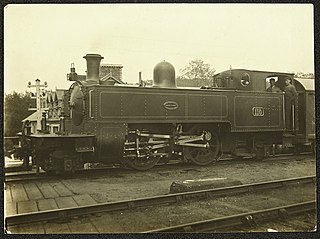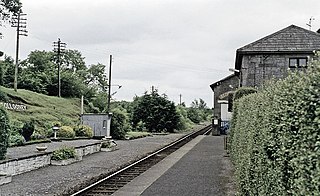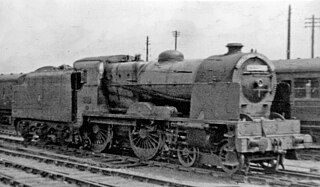Related Research Articles

The Northern Counties Committee (NCC) was a railway that served the north-east of Ireland. It was built to Irish gauge but later acquired a number of 914 mm narrow gauge lines. It had its origins in the Belfast and Ballymena Railway which opened to traffic on 11 April 1848.

The Great Southern Railways Company was an Irish company that from 1925 until 1945 owned and operated all railways that lay wholly within the Irish Free State.

The Great Northern Railway V class steam locomotives were 4-4-0 three-cylinder compound locomotives built in 1932 by Beyer, Peacock & Company for the Great Northern Railway (Ireland).

The Midland Great Western Railway (MGWR) was the third largest Irish gauge railway company in Ireland. It was incorporated in 1845 and absorbed into the Great Southern Railways in 1924. At its peak the MGWR had a network of 538 miles (866 km), making it Ireland's third largest network after the Great Southern and Western Railway (GS&WR) and the Great Northern Railway of Ireland.
This is a bibliography for the history of rail transport in Ireland.
The MGWR Classes F, Fa and Fb are a group of similar classes of 0-6-0 steam locomotives of the Midland Great Western Railway of Ireland which were designed and built between 1921 and 1924. The locomotives could be used to handle goods and also for passenger traffic.

The Belfast and Northern Counties Railway (BNCR) Class S was a class of 2-4-2T two-cylinder compound steam locomotives that was introduced for service on the 3 ft narrow gauge railways of County Antrim in north-east Ireland.

The GS&WR Class 101, classified as Class 101 or Class J15 by the Great Southern Railways, was a class of 0-6-0 steam locomotives designed for working goods traffic although they did, and were quite capable of, working branch and secondary passenger trains.

Collooney railway station serves the town of Collooney in County Sligo, Ireland and is on the Dublin-Sligo railway line. It was the first of three stations to be built in Collooney and remains the only one still in service.

The Great Northern Railway (Ireland) class S was a class of five 4-4-0 steam locomotive that the Great Northern Railway introduced in 1913 to haul Belfast – Dublin express passenger trains. They were followed two years later by the three similar class S2 locomotives.
The Northern Counties Committee (NCC) Class S1 was a class of two-cylinder compound 2-4-2T steam locomotives that was introduced for service on the 3 ft (910 mm) narrow gauge railways of County Antrim in north-east Ireland. The members of the class were rebuilds of the BNCR Class S.
The Northern Counties Committee (NCC) Class S2 was a solitary two-cylinder compound 2-4-4T steam locomotive that was introduced for service on the 3 ft narrow gauge railways of County Antrim in north-east Ireland. It was heavily rebuilt from a BNCR Class S locomotive by the addition of a standard gauge boiler.
The GS&WR 400 class or CIE class B2/B2a were a class of ten 4-6-0 steam locomotives built for the Great Southern & Western Railway (GS&WR) between 1916 and 1923 for express passenger duties on the Dublin to Cork main line. They proved initially unreliable but rebuilds from four to two cylinders between 1927 and 1937 for the seven survivors produced locomotives yielding satisfactory performance with the last two being withdrawn in 1961.
The Belfast Central Railway (BCR) was a railway company operating in Belfast, Northern Ireland. The company was incorporated by act of Parliament in 1872 and acquired by the Great Northern Railway (Ireland) in 1885.

Inchicore railway works, also known locally as 'Inchicore' or 'The Works', was founded by the Great Southern and Western Railway in 1846 and emerged to become the major engineering centre for railways in Ireland. Located c. 3 km west of Dublin city centre, the works cover an area of approximately 73 acres (300,000 m2).

The Midland Great Western Railway (MGWR) A Class, later Inchicore Class D5, consisted of 6 4-4-0 express passenger locomotives built at Broadstone Works in the period 1902-1905. The largest express passenger locomotive in Ireland for a short while after introduction they were used on the MGWR's flagship services to Galway with most surviving until the 1950s albeit on less prestigious work.

The Great Northern Railway (Ireland) (GNRI) VS class steam locomotives were 4-4-0 three-cylinder simple expansion steam locomotives built in 1948 by Beyer, Peacock and Company. They were procured in order to operate the Enterprise train service between Dublin and Belfast and were the last series of steam engines ordered by the company.
The Dublin, Wicklow and Wexford Railway (DW&WR) 2, built in 1885, was the predecessor to a total of eleven 2-4-0T locomotives to emerge from Grand Canal Street railway works between 1885 and 1896.
Robert Coey (1851–1934) was a locomotive superintendent of the Great Southern and Western Railway (GS&WR) of Ireland from 1896 until 1911.
The GS&WR McDonnell 2-4-0 types were a set of passenger locomotive classes introduced on the Great Southern and Western Railway (GS&WR) of Ireland by its locomotive engineer Alexander McDonnell between about 1868 and 1877.
References
- ↑ Rowledge 1993, pp. 40–42.
- ↑ "Locomotives of the Belfast and County Down Railway". The Belfast & County Down Railway Museum Trust. Archived from the original on 17 August 2013. Retrieved 4 June 2013.
- ↑ Rowledge 1993, pp. 116–118.
- ↑ Rowledge 1993, p. 118.
- ↑ Ahrons (1954), pp. 66–80.
- ↑ Ahrons (1954), p. 69.
- 1 2 3 Rowledge 1993, pp. 37, 56, 114.
- 1 2 Rowledge 1993, pp. 115.
- ↑ Haresnape & Rowledge (1982), pp. 17–27
- 1 2 Kullman, Kurt (28 May 2018). "Rolling Stock". "The First Irish Railway: Westland Row to Kingstown". THP Ireland. p. 45. ISBN 978-0750987646.
- 1 2 3 4 5 6 Murray, K. A. (1981). "10 — Locomotives". Ireland's First Railway. Irish Railway Record Society. ISBN 0904078078.
- 1 2 3 4 5 "Dublin's First Railway". Dublin Historical Record. 1 (2): 36−37. JSTOR 30080094.
- ↑ Shepherd, Ernie (1988). The Dublin & South Eastern Railway (1988 ed.). Midland Publishing Ltd. p. 140,199,202. ISBN 1 85780 082 6.
- ↑ Tom Rolt
- ↑ Clements, Jeremy; McMahon, Michael (2008). Locomotives of the GSR. Colourpoint Books. ISBN 9781906578268.
- ↑ Baker, Michael H. C. (1972). "Irish railways since 1916". Ian Allan Publishing. ISBN 0711002827.